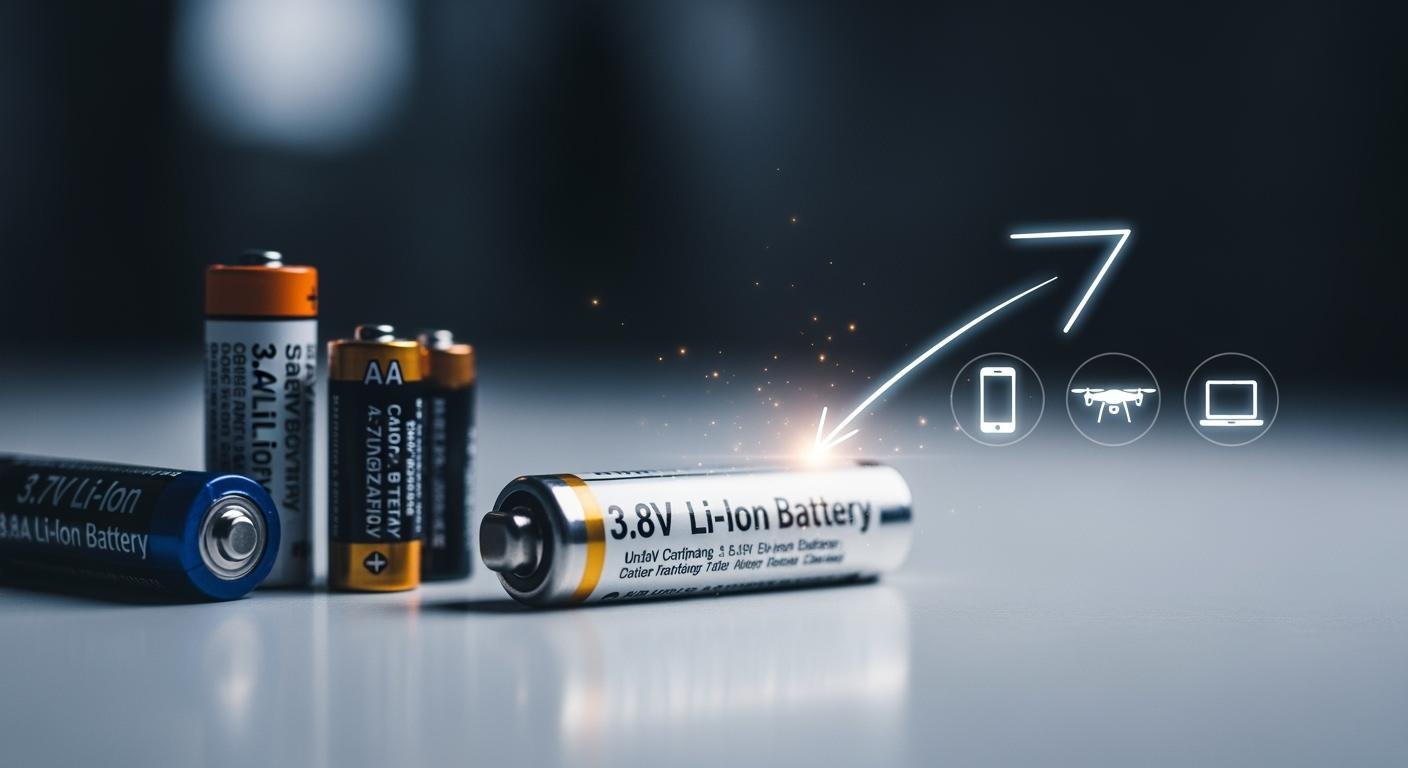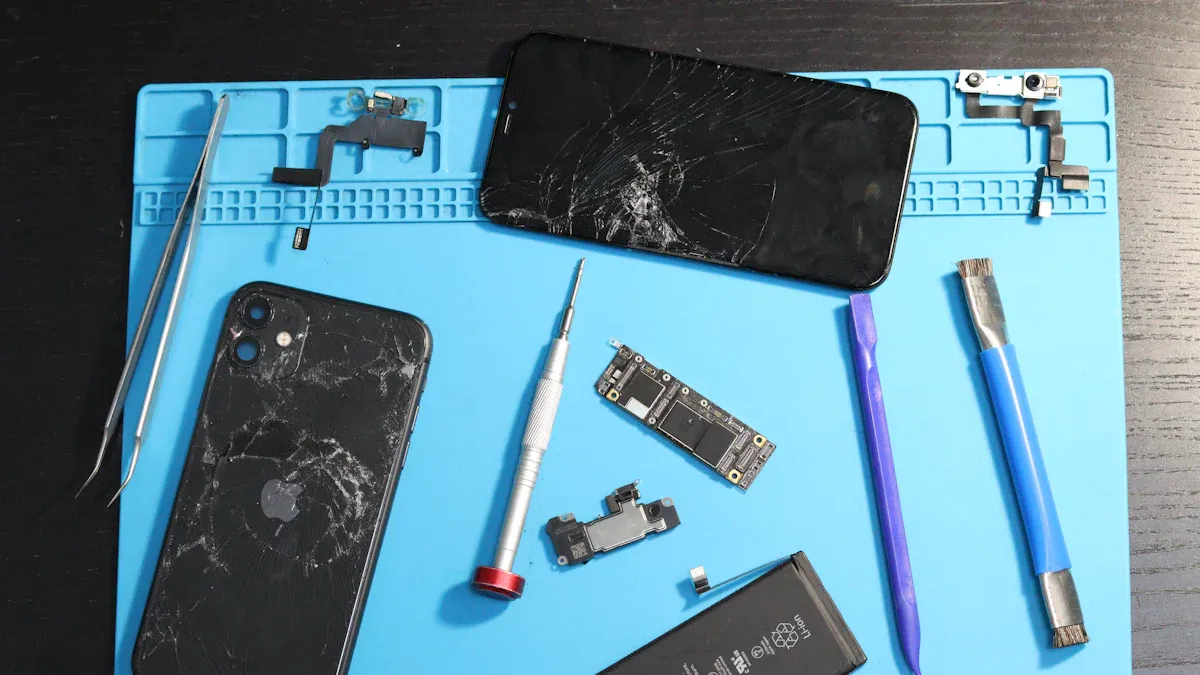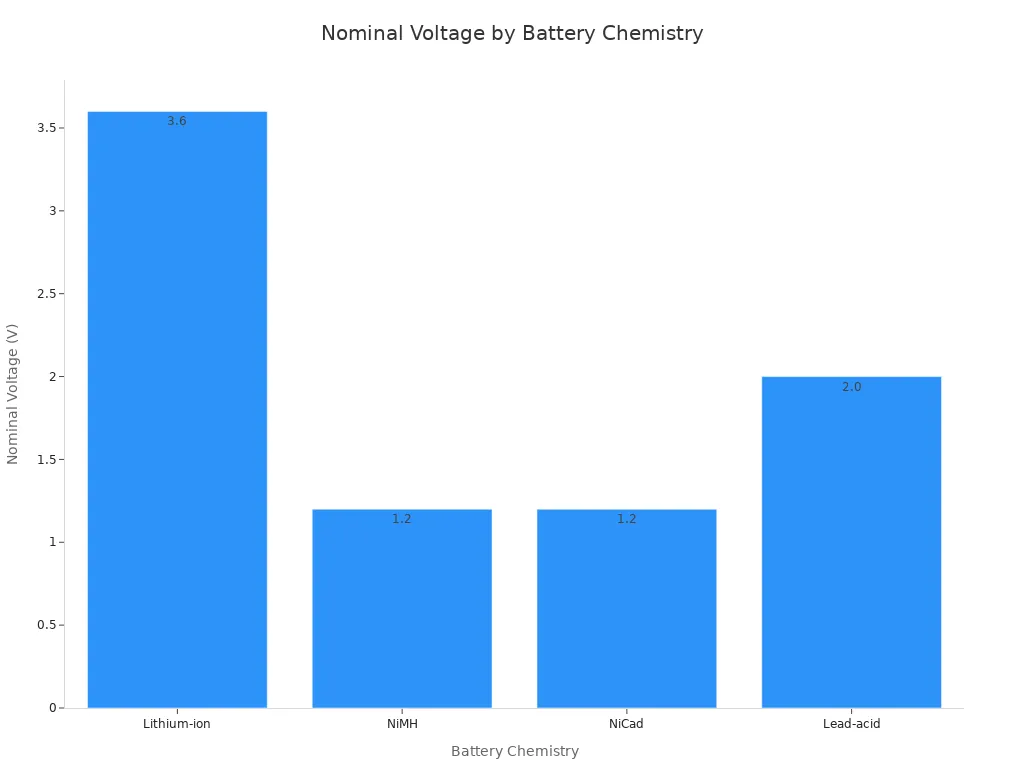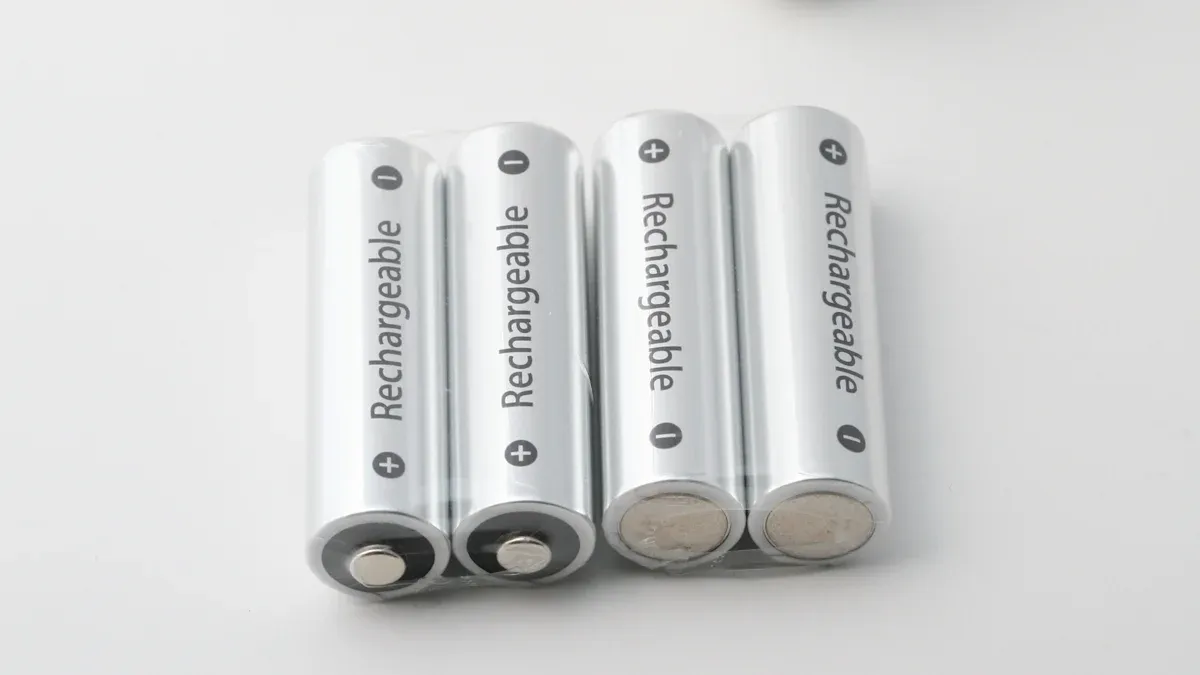
Engineers select 3.8V li-ion batteries to maximize battery capacity and extend battery life within a compact design. This higher voltage lithium-ion battery technology powers devices like smartphones and high-performance drones. The choice of battery voltage is critical. A device’s entire system, including its battery management, must be built for this specific battery. The charge and discharge cycles depend on precise engineering for the higher lithium battery voltage. This careful battery management ensures safety and performance.
3.8V vs 3.7V: The Energy Density Advantage

The primary benefit of 3.8V li-ion batteries is their superior energy density. Engineers can pack more power into the same physical space. This allows for a longer battery life without making a device bigger or heavier. A 3.8V lithium battery can offer 20-30% higher energy capacity than a standard 3.7V battery of the same size. This significant boost in capacity is crucial for modern electronics.
Understanding Nominal Voltage
Nominal voltage is the average voltage a battery provides during its discharge. It is a standard number that helps engineers design systems. A lithium-ion battery’s actual voltage changes. It is highest when full and lowest when empty. The nominal voltage represents the typical operating voltage. For example, a cell might range from 4.2V (full charge) to 3.0V (empty), but its nominal voltage is listed as 3.7V.
Manufacturers determine a battery’s nominal voltage based on its internal chemistry. Different materials produce different voltage levels. Advanced cathode materials in 3.8V cells enable their higher voltage.
| Type de batterie | Everyday Chemistry |
|---|---|
| 3.7V Li-ion Cell | Lithium Cobalt Oxide (LiCoO2) or Lithium Manganese Oxide (LiMn2O4) |
| 3.8V Li-ion Cell | Often uses advanced cathode materials or additives to enable higher voltage |
This difference in chemistry is the key to their enhanced battery performance. Other battery types have their own standard voltages.

How Higher Voltage Boosts Runtime
A higher battery voltage directly increases a device’s runtime. The total energy in a battery is measured in Watt-hours (Wh). This value determines the total battery life. The formula to find this energy is simple.
Energy (Watt-hours) = Capacity (Amp-hours) × Voltage (Volts)
Let’s compare two batteries, each with a 3 Amp-hour (Ah) capacity.
- A standard 3.7V battery provides 11.1 Wh of energy (3 Ah x 3.7V).
- A high-voltage 3.8V battery provides 11.4 Wh of energy (3 Ah x 3.8V).
The 3.8V battery stores more total energy. This extra energy translates directly to a longer battery life for the user. A device powered by the 3.8V battery will run longer on a single charge. This increase in battery capacity is achieved without changing the battery’s physical size, making it ideal for compact devices where every minute of discharging time counts. The higher voltage allows for a more efficient discharge, extending the useful capacity and battery life. The process of discharging the battery is more efficient, giving more power over the discharge cycle. A longer discharging period improves the user experience. The battery capacity is a key factor in extending discharging time.
The Lifespan Trade-Off
The increased capacity and longer battery life of 3.8V li-ion batteries come with a trade-off. The higher energy density can reduce the battery’s overall lifespan. This happens because of the stress from a higher charge voltage. A standard 3.7V battery charges to a maximum of 4.2V. A 3.8V battery, however, must charge to a higher voltage, often 4.35V, to reach its full capacity.
This higher charge state puts more stress on the battery’s internal components. It accelerates chemical reactions that degrade the lithium battery over time. These reactions can cause:
- Internal Buildup: Unwanted materials can form inside the battery, a process known as Solid Electrolyte Interphase (SEI) growth.
- Lithium Plating: Tiny metallic lithium structures can grow, which can reduce capacity and cause safety issues.
- Material Breakdown: The cathode material itself can begin to break down under the high voltage stress.
These factors cause the battery to lose its ability to hold a full charge more quickly. Over many charge and discharge cycles, the battery capacity will decrease faster than a standard 3.7V battery. Engineers must balance the need for a long daily battery life with the battery’s total long-term lifespan. The goal is to maximize discharging time without prematurely wearing out the battery. The charge and discharge cycles slowly reduce the battery’s maximum capacity. A careful charge management system is essential for a good battery life. The discharging process also contributes to this wear.
Where to Find 3.8v Li-ion Batteries
Engineers use 3.8v li-ion batteries in many popular high-performance electronics. These devices require a long battery life and a large battery capacity in a small package. The advanced lithium chemistry allows for a powerful battery that supports a long discharge cycle.
Modern Smartphones and Tablets
Modern smartphones and tablets are the most common place to find these advanced batteries. Manufacturers want to give users the longest possible battery life without making the device thick or heavy. A higher capacity lithium battery helps them achieve this goal. The battery must hold its charge for a full day of use. For example, some tablets offer extended video playback, showing the power of a high-capacity battery.
- Certain Samsung Galaxy Tab models provide up to 23 hours of video playback.
- Other models offer up to 18 hours of video playback on a single charge. This impressive battery life is possible because the internal battery has a high energy capacity. A long discharging time is a key selling point. The lithium-ion battery’s ability to handle a deep discharge is crucial.
High-Performance Drones and RC
High-performance drones and remote-control (RC) vehicles need a powerful and lightweight battery. A battery’s weight directly affects a drone’s flight time and agility. The higher energy capacity of a lithium battery provides a significant advantage. This improved battery life allows for longer flights.
For drones, these batteries are an excellent choice. Their lightweight nature and high energy density are crucial for maximizing flight time and overall performance. A full charge provides more power for a longer discharge.
Professional racing drone brands use high-voltage lithium-ion packs. For instance, some Tattu R-Line batteries use four 3.8V cells. These packs charge to a higher voltage (4.35V per cell) than standard packs. This gives the drone more power and extends its battery life during a race. The battery capacity is designed for a rapid discharge.
Compact Wearables and IoT Devices
Smartwatches and other compact Internet of Things (IoT) devices have very little internal space. Every millimeter matters. Engineers often use a single-cell lithium battery to power these gadgets. Smartwatches frequently contain a small battery with a capacity between 130mAh and 410mAh. This small battery capacity must still provide all-day battery life. The battery must efficiently manage its charge and discharge cycles. A long discharging period is essential for user satisfaction. The choice of battery ensures the device remains functional between each charge.
Critical Compatibility and Safety Rules

Users must understand the critical rules for handling 3.8V lithium batteries. The single biggest risk comes from charging incompatibility. A device’s internal systems, especially its battery management, are precisely engineered for a specific battery voltage. Mixing components creates serious risks and undermines performance, affecting the battery life and overall capacity. Proper battery management is essential for safe operation.
The Dangers of Mismatched Chargers
Using the wrong charger is extremely dangerous. A 3.8V lithium battery requires a charger that delivers a full charge at 4.35V. A standard 3.7v battery uses a charger that stops at 4.2V. Attempting to charge a standard lithium-ion battery with a 4.35V charger is a severe overcharge. This small voltage difference can cause catastrophic failure.
Overcharging a battery triggers dangerous chemical reactions inside the lithium cell. These reactions permanently damage the battery and create a significant fire hazard, compromising battery safety.
- Lithium Plating: Excess lithium metal builds up on the anode, reducing the battery’s capacity and increasing internal resistance.
- Cathode Damage: The high voltage starts to break down the cathode material, further reducing the battery’s ability to hold a charge.
- Self-Heating: The chemical reactions generate heat. This can lead to a dangerous state called thermal runaway, where the battery can catch fire or explode.
⚠️ Safety Alert: Inspect Your Battery A damaged battery often shows visible warning signs. Users should immediately stop using any battery that is swelling, bulging, discolored, or emitting a strange odor. These signs indicate internal failure and a serious risk. Proper battery management includes regular inspection.
This damage drastically shortens the battery life. The battery loses its capacity to hold a full charge. The discharge and discharging cycles become shorter and less reliable. The entire battery management system cannot protect a battery from the wrong charge voltage.
Why You Can’t Swap a 3.7v Battery
A user cannot simply swap a 3.8V battery with a 3.7v battery, even if they are the same physical size. The device’s electronics are designed for the higher battery voltage of a 3.8V cell. A device expecting 3.8V will misinterpret the lower voltage from a 3.7V battery. This mismatch affects the device’s ability to estimate the remaining battery life.
The device might shut down unexpectedly, even when the battery still has a charge. The system’s battery management software sees the lower voltage and assumes the battery is empty. This leads to a frustrating user experience with poor battery life. The device cannot complete a normal discharge cycle. The full capacity of the battery is never used. This makes the discharging process inefficient. The battery management system cannot correctly track the charge level, leading to unreliable performance and a shorter perceived battery life. The battery will not deliver its expected capacity during discharge.
Device and BMS Requirements
Every modern lithium-ion battery system relies on a Battery Management System (BMS). The BMS is a small circuit board that acts as the brain for the battery. It ensures safety and maximizes battery life. The BMS is not interchangeable. A BMS designed for a 3.8V battery is calibrated for its specific voltage range and charge characteristics. This precise battery management is key to a long battery life.
The BMS constantly monitors several key parameters to protect the battery and the device. Effective battery management depends on accurate sensor data.
| Sensor | Parameter Monitored | Objectif |
|---|---|---|
| Voltage Sensor | Cell Voltage | Prevents over-charge and over-discharge. |
| Current Sensor | Current Flow | Manages the rate of charge and discharge. |
| Temperature Sensor | Battery Temperature | Avoids overheating during charge or discharge. |
The BMS uses this information to calculate the battery’s State of Charge (SOC) and State of Health (SOH). The SOC tells the user how much capacity is left. The SOH indicates the overall battery life. This detailed battery management ensures the lithium battery operates within safe limits.
A critical function of the BMS is providing over-voltage and under-voltage protection. Over-voltage protection stops the charge when the battery voltage reaches its limit (e.g., 4.35V), preventing damage. Under-voltage protection stops the discharging process when the battery voltage drops too low. This prevents the cells from being fully drained, which can permanently damage the battery and reduce its capacity. This careful battery management is fundamental to battery safety and a long battery life.
Engineers choose 3.8V li-ion batteries to maximize battery capacity and extend battery life in high-performance devices. This choice is a deliberate engineering decision. Users must respect this design for safety and optimal battery performance. The battery voltage of a replacement lithium battery must always match the original. A 3.7V battery cannot replace a 3.8V battery, as this impacts the charge and discharge cycles. Proper handling of any lithium-ion battery is critical.
- Secure battery compartments to prevent access.
- Ensure the product and packaging include clear warnings.
- Provide all safety instructions in the manual.
Following these rules ensures a safe experience and protects the device’s capacity for a long battery life. The discharging process depends on the correct voltage.
FAQ
Can a 3.7V device use a 3.8V lithium battery?
No, a device needs the correct battery voltage. A 3.7V device cannot handle the higher voltage of a 3.8V lithium battery. This mismatch harms the device’s electronics and ruins the battery life. The system cannot manage the different charge and discharge profiles, affecting battery capacity and overall battery life.
Why do 3.8V lithium batteries have a shorter lifespan?
The higher charge voltage stresses the lithium battery. This stress speeds up chemical decay during each charge and discharge cycle. The battery loses its capacity to hold a full charge faster. This trade-off gives better daily battery life but reduces the total long-term battery life and battery capacity.
How does a person identify a 3.8V lithium battery?
A person can check the label printed on the battery. Manufacturers list the nominal voltage, capacity, and chemistry. A 3.8V lithium battery will clearly state “3.8V” or “3.8Vdc”. This information is vital for a safe charge and discharge. It ensures the battery capacity and battery life meet expectations.
What happens during an incorrect charge?
An incorrect charge is dangerous. Using the wrong charger causes the lithium battery to overheat during the charge. This damages the internal parts, reduces battery capacity, and shortens battery life. The discharging process also becomes unsafe. A proper charge and discharge cycle is critical for battery life and preserving capacity. The discharging process depends on a safe charge. The discharging process impacts battery life. The discharging process affects battery capacity. The discharging process is key to battery life. The discharging process needs a correct charge. The discharging process is part of the battery life cycle. The discharging process affects the battery. The discharging process uses the battery’s charge. The discharging process impacts battery life.

